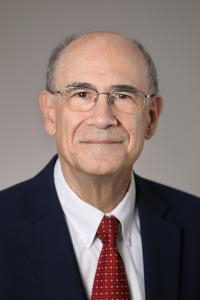 |
| Mark Hallett |
Magnetic stimulation can be used to diagnose central nervous system diseases that slow the conduction velocity in motor nerves without changing the conduction velocity in sensory nerves (Hallett and Cohen 1989).The reference is to a wonderful paper that Hallett and Leo Cohen wrote in the Journal of the American Medical Association.
Hallett M, Cohen LG (1989) Magnetism: A new method for stimulation of nerve and brain. JAMA 262:538–541.Hallett came to NIH in 1984 and worked there for almost 40 years. I collaborated with him in the early 1990s, when I was working in NIH’s Biomedical Engineering and Instrumentation Program. My role was to calculate the electric field induced in the brain during transcranial magnetic simulation.
For a long time, Hallett was the clinical director for the National Institute of Neurological Disorders and Stroke intramural program. According to Google Scholar, his papers are cited about ten times every day, and his h-index is over 100, meaning he has published over 100 papers that have each been cited over 100 times. He has had an enormous impact on the field of neurophysiology. In particular, he trained an amazing number of young scholars who have gone on to be leaders in the field themselves, many of who spoke at the event.
 |
| Mark Hallett |
Dr. Hallett obtained his A.B. and M.D. at Harvard University, had his internship in Medicine at the Peter Bent Brigham Hospital and his Neurology training at Massachusetts General Hospital. He had fellowships in neurophysiology at the NIH and in the Department of Neurology, Institute of Psychiatry in London, where he worked with C. David Marsden. Before coming to NIH in 1984, Dr. Hallett was the Chief of the Clinical Neurophysiology Laboratory at the Brigham and Women's Hospital in Boston and progressed to Associate Professor of Neurology at Harvard Medical School. He is currently Chief of the Medical Neurology Branch and Chief of its Human Motor Control Section. He is now Past-President of the International Federation of Clinical Neurophysiology. He has been President of the International Parkinson and Movement Disorder Society and Vice-President of the American Academy of Neurology. He served as Editor in Chief of Clinical Neurophysiology. Among many awards, in 2012 he became an Honorary Member of the American Neurological Association, and in 2014 won the Lifetime Achievement Award of the American Association of Neuromuscular and Electrodiagnostic Medicine. In 2017 he received the degree of Doctor of Medicine Honoris Causa from the University of Hamburg, and in 2018 was made an Honorary Member of the European Academy of Neurology. His research activities focus on the physiology of human voluntary movement and its pathophysiology in disordered voluntary movement and involuntary movement.
Once Hallett told me that he started out college studying physics, but when his instructor explained to his class that a magnetic field is just a relativistic effect of an electric field (see Problem 5 in Chapter 8 of IPMB) he switched to a premed program!
At the end of his Festschrift, Hallett spoke and honored his many mentors. His final words were "I will be retiring, but not too much."
Enjoy your retirement, Mark Hallett, but not too much. Working with you was a delight.
https://www.youtube.com/watch?v=eR-D9bLWKhQ
Oral History 2013: Stanley Fahn Interviews Mark Hallett



Watch the Mark Hallett Festschrift at https://videocast.nih.gov/watch=46497
ReplyDelete